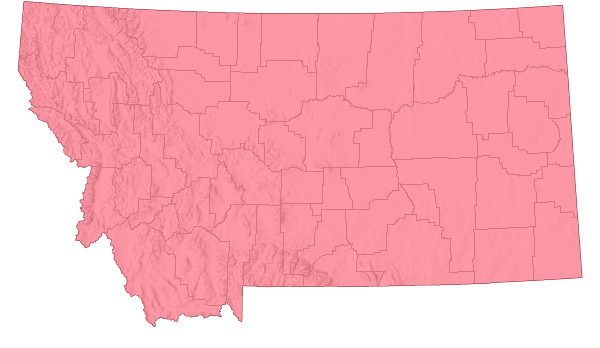View in other NatureServe Network Field Guides
NatureServe
Montana
Utah
Wyoming
Idaho
Wisconsin
British Columbia
South Carolina
Yukon
California
New York
American Cranberrybush - Viburnum opulus
Non-native Species
Global Rank:
G5
State Rank:
SNA
(see State Rank Reason below)
C-value:
1
Agency Status
USFWS:
USFS:
BLM:
External Links
State Rank Reason (see State Rank above)
Viburnum opulis has been documented at 11 locations in western Montana. It was first documented along a manmade ditch in 1973. Since then it has been found in natural areas or along rivers all within city limits, and in Lee Metcalf Wildlife Refuge. Several herbarium specimens state that the plant may have been dispersed from birds and/or sourced by nearby gardens. Therefore Viburnum opulus is considered to be introduced in Montana and is ranked as SNA because a conservation status rank is not applicable for exotic species.
- Details on Status Ranking and Review
Range Extent
ScoreD - 1,000-5,000 sq km (~400-2,000 sq mi)
Area of Occupancy
ScoreD - 6-25 4-km2 grid cells
Number of Populations
ScoreB - 6 - 20
Environmental Specificity
ScoreD - Broad. Generalist or community with all key requirements common
General Description
Stems spreading to erect, branched, 1–3 m; twigs green-brown, glabrous. Leaves stipulate; blades ovate, 3-lobed above, dentate or lobed again, 4–10 cm long, hirsute beneath; lobes acuminate. Inflorescence 6–10 cm across. Flowers corolla subrotate, 2–3 mm long; outermost ring of flowers rotate, sterile, 1–2 cm across. Drupe red, 10–15 mm long (
Lesica et al. 2012. Manual of Montana Vascular Plants. BRIT Press. Fort Worth, TX).
Species Range
Montana Range
Range Descriptions

 Non-native
Non-native
Range Comments
BC to NL south to WA, MT, SD, IL and PA; Europe (Lesica et al. 2012). It is presumed to have escaped from cultivation in MT.
Observations in Montana Natural Heritage Program Database
Number of Observations: 57
(Click on the following maps and charts to see full sized version)
Map Help and Descriptions
Relative Density

Recency



 (Observations spanning multiple months or years are excluded from time charts)
(Observations spanning multiple months or years are excluded from time charts)
Habitat
In riparian forests and along rivers and ditches within areas of anthropogenic influence. Valleys.
Ecology
It is likely spread by birds.
Potential and Known Pollinators:
The following animal species have been reported as pollinators of this plant species or its genus where their geographic ranges overlap:
Bombus pensylvanicus and
Bombus griseocollis (Colla and Dumesh 2010).
Management
Stewardship Responsibility
References
- Literature Cited AboveLegend:
 View Online Publication
View Online Publication Lesica, P., M.T. Lavin, and P.F. Stickney. 2012. Manual of Montana Vascular Plants. Fort Worth, TX: BRIT Press. viii + 771 p.
Lesica, P., M.T. Lavin, and P.F. Stickney. 2012. Manual of Montana Vascular Plants. Fort Worth, TX: BRIT Press. viii + 771 p.
- Additional ReferencesLegend:
 View Online Publication
View Online Publication
Do you know of a citation we're missing? Lesica, P., M.T. Lavin, and P.F. Stickney. 2022. Manual of Montana Vascular Plants, Second Edition. Fort Worth, TX: BRIT Press. viii + 779 p.
Lesica, P., M.T. Lavin, and P.F. Stickney. 2022. Manual of Montana Vascular Plants, Second Edition. Fort Worth, TX: BRIT Press. viii + 779 p. Little, E.L., Jr. 1979. Checklist of United States trees (native and naturalized). Agriculture Handbook No. 541. U.S. Forest Service, Washington, D.C. 375 pp.
Little, E.L., Jr. 1979. Checklist of United States trees (native and naturalized). Agriculture Handbook No. 541. U.S. Forest Service, Washington, D.C. 375 pp.
- Web Search Engines for Articles on "American Cranberrybush"





